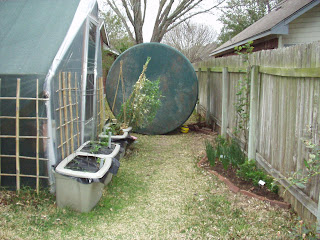

Although I was sad to pronounce it dead and see it go, the oleander had developed a fatal virus that "burned" its leaves and left it lifeless. We'd been giving it lots of extra love and attention since moving into the house, but finally realized it was time. Not only that, it was right where we wanted to install the rain tank. It may have been lifeless above ground, but it had an amazing root system that required days to defeat.
With the oleander stump removed, we needed to provide a level pad on which to place the tank. This part of the yard slopes, so we decided to build a frame to keep the soil from washing away. How many of you ever bought a bag of "topsoil" only to wonder how anyone could bag and sell that awful stuff? Well, we found a perfect use for it. We used it to build up inside the frame. At about $1.20 for a half cubic foot - it's much cheaper than the $3.00 bags of pea gravel we are also using. We used the topsoil to build up to about an inch and a half from the top of our wooden frame, then topped off with the pea gravel and levelled it. We used bagged product rather than having a load delivered as it was easier for us old folks to manage the bags. Above, Brady checks the first layer out and pronounces it ready for the pea gravel. After pouring on the pea gravel, I smoothed it out and checked it with a level.
Next step is getting guttering installed. I've gotten bids on 4" and 6" guttering with screens and with the solid leaf guards. Know ahead of time there will be some ongoing cleaning required with screens, but the cost is about half of the systems with solid guards. And, although smaller widths are available, 6" guttering is usually recommended to handle heavy downpours without loss. The "helmets" or "leaf shields" aren't entirely necessary when the water is just being used in landscape applications. They do cut down dramatically on the amount of gravel that is washed into the gutter, but the "first flush" pipe gives you an opportunity to get rid of most of what works its way towards the tank. It's a pipe installed in the downward flow of water from the gutter that must fill up before water can move on toward the collection tank. It has a removeable cap that allows you to drain the debris out from time to time, including gravel from a composite roof or bird poop or leaves and organic gunk that work their way into the system.
When I was taking the rainwater harvesting training, we were actually making some of the parts as they couldn't easily be purchased in the US - things like the transition piece from the rectangular guttering to round PVC piping for downspouts running into collection tanks. Australia is way ahead of the United States in this area. However, most guttering companies in Austin now carry prefabricated transitions in both metal and PVC made specifically for rainwater harvesting applications. All three companies I've contacted have done lots of rainwater projects and knew what I needed without me telling them. They also worked into their bids a plan for the possibility of adding additional barrels or tanks in the future. They've done this enough to learn it's addictive. How could saving money on water bills or having enough and better quality water for your plants be a bad thing?
By the way, if this size tank scares you, Corinne at Triple S says they also have smaller options: a green tank that holds approx. 1164 gallons that's 53" tall and 86" wide, a green tank that holds 556 gallons that's 64" tall by 48" wide, and a green tank that holds 319 gallons that's 52" tall and 46" wide. I mention the color "green" because the tanks are also made by another manufacturer in black. The capacities and specs are slightly different. She says to feel free to call her at 512.243.0679 if you need any other information. And, don't hesitate to start with just a barrel. Many cities, including Austin, have reduced cost rain barrels available. Really, like I said, how can it be a bad thing - even on a smaller scale!
Enough for today. I'm hoping to have this installed soon and start catching those pennies from heaven. That phrase has certainly taken on new meaning with frequent droughts and climate change, hasn't it? Austin has lots of gardening fairs, garden tours, and gardening seminars filling the calendar in March and April. Then it's time for Spring Fling! Have to remember to make time for playin' outside! Let me hear from you - what's pushing its way to the top of your to-do list?


Comments
Regards
Karen
Rapidly pushing its way to the top of my to-do list is replacing the wood fence around our backyard. It's in really poor condition, and several other projects hinge on having it done.
It's very interesting to see the project in process - now just hope we get some rain for you to harvest!
Annie at the Transplantable Rose
Thanks for the next chapter of the rain barrel saga. Great stuff. Like a harlequin romance for gardeners!